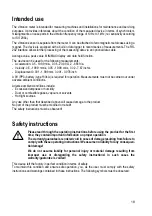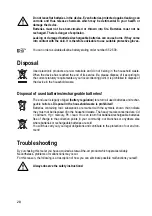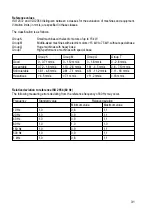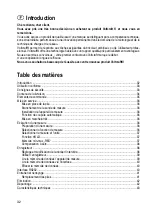
22
Operation
Inserting the battery
Before first use you must insert a 9V (PP3, alkaline) battery in the meter. See chapter “Maintenance and
cleaning” on how to insert the battery.
Connecting the measuring sensor
Connect the round sensor plug (12) to the connection (1) on the meter. Turn the plug to lock it (bayonet
connector). Always make sure the plug is connected tightly to avoid faulty measurements.
Setting up the meter
To facilitate reading, the meter can be set up using the tilt stand on its back (10).
The device can be mounted on a tripod using the tripod socket (8).
Automatic power-off
To keep battery lifetime as long as possible, the device has an automatic power-off function. The meter
is automatically switched off if no button has been pressed over a period of about 10 minutes. You can
switch the meter back on by pressing the “POWER” button (3).
In recording mode (REC) automatic power-off is deactivated.
Switching on/off
Press the “POWER” button (4) to switch on the meter. After a short while initialisation (display and sys-
tem test) is complete and the meter is ready for use.
Hold down the “POWER” button (4) for about 2 seconds to switch off the device. The device shuts down
with a signal tone.
Carrying out a measurement
Watch out for moving parts when measuring. Risk of injury!
Only currentless surfaces may be measured. The temperature at the sensor must not
be outside the specified temperature range. After every measurement, remove the
sensor from the test object and switch off the meter.
Preparing to measure
- Connect the sensor to the meter (1) at the bayonet connector (12). Turn the plug until it engages.
- Press the “POWER” button to switch on the device.
- Hold the sensor (13) against the position at which to measure. Ensure proper flatness. When dealing
with ferromagnetic materials (e.g. iron), the provided screw-on magnet (14) can be screwed onto the
sensor (13). It will stick to the metal to facilitate your work.
















































